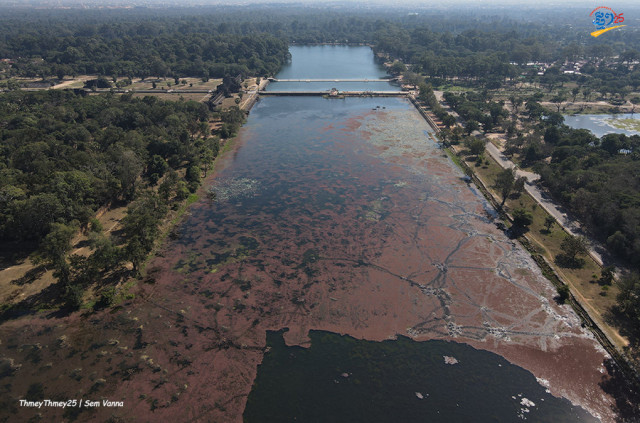A Moat That Keeps the Temple Steady and People Happy

- By Long Ton
- June 7, 2022 4:53 PM
SIEM REAP–The vast majority of domestic and foreign tourists who arrive at Angkor Wat for the first time wonder whether the water surrounding the temple is a lake or a river.
The magnificent sandstone structures of this historical monument are already well known all over the world. However, despite the intricacy and the ginormous size of the temple, being able to witness such a spectacular sight in all its beauty from the other side of the moat is another unique experience.
The fact that there is a man-made shallow moat surrounding the temple and with a width of nearly 200 metres makes this a very astonishing scenery for all of us since this moat is another solid proof of the ancient Khmer people’s prodigious architectural ability. And then, some people wonder and would like to find out how many workers were involved in the construction of the Angkor Wat’s moat.
According to the research done by several historians, archaeologists and other specialists, the construction of this big canal of approximately 1,500 meters from east to west and about 1,300 metres from north to south was carefully planned. The Khmer architects of the 12th century AD had thoroughly studied the relation in geometry regarding the ratio between the size of the building and the size of the site required that was indispensable. Moreover, the use of sand to fill the foundation of the building in order to create this kind of mountain temple is crucial as well. In addition, the moat around the temple does not only play the role of symbol of the ocean in Hinduism: According to engineers, this very large ditch also serves to keep the physical balance of this huge construction and preventing it from crumbling under its own heavy weight as water usually reinforces the strength of sand.
Through the constant maintenance and improvement work conducted by the Apsara National Authority, which today oversees the Angkor Archaeological Park, and the international institutions and teams working at this UNESCO World Heritage site, maintenance and repair are being constantly done all over this huge protected site to preserve the majestic monuments. As for the source of water supplying the moat, there are canals linking the Siem Reap stream to those of the ancient city Angkor Thom built some 800 years ago. Furthermore, rainfall during the rainy season also contributes to filling up the moat with water. That is the reason why some experts have coined a name for this old city: the “City of Water.”
With its water sparkling in the light, its gentle waves created by the wind, the blanket of mist in the early morning, the sound of cicadas during cooler evenings and the surrounding giant trees, the moat is a very attractive place for both domestic and foreign tourists, and especially for those who like to take pictures or simply relax, take a breath of fresh air or exercise whether by cycling, walking or jogging. If we look closely, we see that, all along the moat, many people come to visit not only on major national holidays or weekends, but also on a daily basis during the day or at sunset.
For those wishing to come by car, they can arrive from the northern and north-eastern corners of the moat and then take the narrow trail through the forest on the east side of the moat or go through the village located on the northern side of the moat. Those who prefer a peaceful atmosphere and tranquillity can visit the north and northeast part of the site.
Long Ton is a Cambodian with a passion for Angkor and that era. A university graduate who speaks several languages, he has conducted tours at Angkor.
Cheng Ousa contributed to the story.















